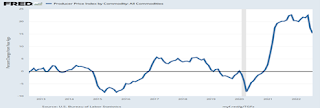The Fed is beginning to ease its purchases of Treasury and Mortgage-backed securities in its push to raise interest rates and lower inflation, a policy called Quantitative Tightening (QT) as opposed to the various Quantitative Easing efforts (QE) when it wanted to boost inflation by increasing the money supply in 2009 at the end of the Great Recession.
But what if QT, accompanied by the Fed’s short term interest rate hikes—3 percent to date with its federal funds rate up to a range of 3%-3.25%, which is the highest it has been since early 2008—results in shrinking the money supply so much that it causes a recession, or worse?
It’s possible if the Fed continues to boost interest rates while the worldwide energy and food crunch, which is the real reason wholesale and retail prices have risen so fast, ends almost as quickly as it began.
The Fed would then have to reverse course for fear we might fall into a disinflationary spiral, or worse; deflation as Japan experienced in a decade of lost growth. QE enabled our recovery from the Great Recession, a recession almost as bad in terms of lost assets as the Great Depression.
I reported recently that economists such as Nobel Prize-Winner Joe Stiglitz are beginning to signal that possibility.
“Monetary policy typically affects economic performance with long and variable lags, especially in times of upheaval,” said Professor Stiglitz in a recent Project Syndicate article. “Given the depth of geopolitical, financial, and economic uncertainty – not least about the future course of inflation – the Fed would be wise to pause its rate hikes and wait until a more reliable assessment of the situation is possible.”
Some Wall Streeters are joining the chorus to slow down the rate increases. Cathie Wood, CEO of hedge fund Ark Invest, and a vocal proponent of deflation, is getting a few high-profile supporters even as price pressures continued to surprise to the upside, as reported by CNBC.
Jeffrey Gundlach and Elon Musk recently joined Wood’s camp in calling for a decline for prices, expressing worries that the Federal Reserve might go too far. Bond King Gundlach warned of the deflation risk on Tuesday, urging investors to buy long-term Treasurys. Meanwhile, the Tesla CEO called falling commodity prices “neither subtle nor secret” and tweeted to his 100 million followers that “a major Fed rate hike risks deflation.”
Wood has been warning about deflation since last year and is now doubling down on her call as several leading indicators she watches are pointing to deflationary forces instead of inflation, says CNBC.
““Leading inflation indicators like gold and copper are flagging the risk of deflation,” Wood said. “Even the oil price has dropped more than 35% from its peak, erasing most of the gain this year.” Gold prices have slid 6% so far this year. “Inflation is turning into deflation,” she said.
There was a real deflation danger in 2009 and a reason for QE. More precisely, the retail Consumer Price Index used to measure retail inflation had sunk to a minus -1.96 percent with little sign of rising after the shock of the Lehman Brothers collapse and possibility that many other firms on Wall Street were also in danger of collapse.
Congress and the GW Bush administration raised more than $700 billion to save the banks and Wall Street at the time, but it took years to raise the inflation rate back to 2 percent.
That’s our past history, which seems to put the Fed between a rock and a hard place, as the saying goes. Should it allow the inflation rate to continue to decline on its own, as it is doing, or speed up the process of decline, thus threatening a more severe downturn?
Yikes, what a situation to be in!
Harlan Green © 2022
Follow Harlan Green on Twitter: https://twitter.com/HarlanGreen







